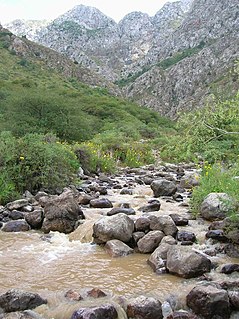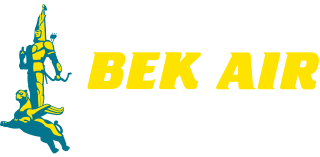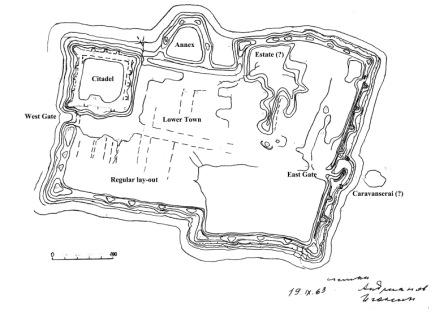
Kazakhstan, the largest country fully within the Eurasian Steppe, has been a historical crossroads and home to numerous different peoples, states and empires throughout history.
The vast territory of Kazakhstan spans across 2,700,000 km2 (1,000,000 sq mi). The population density is low in Kazakhstan, and the centers of industry and agriculture are spread out and remote from world markets.

The Syr Darya, historically known as the Jaxartes, is a river in Central Asia. The name, a borrowing from the Persian language, literally means Syr Sea or Syr River, and sometimes it is referred to in this way. It originates in the Tian Shan Mountains in Kyrgyzstan and eastern Uzbekistan and flows for 2,256.25 kilometres (1,401.97 mi) west and north-west through Uzbekistan and southern Kazakhstan to the northern remnants of the Aral Sea. It is the northern and eastern of the two main rivers in the endorheic basin of the Aral Sea, the other being the Amu Darya (Jayhun).

Almaty, or Alma-Ata, and formerly Verniy (1854–1921), is the largest city in Kazakhstan, with a population of about 2 million. It was the capital of Kazakhstan from 1929 to 1997, when the government relocated the capital to Akmola.

Baikonur, formerly known as Leninsk, is a city of republic significance in Kazakhstan on the northern bank of the Syr Darya river, rented and administered by the Russian Federation as an enclave. It was constructed to service the Baikonur Cosmodrome and was officially renamed Baikonur by Russian president Boris Yeltsin on December 20, 1995. During the Soviet period, it was sometimes referred to as Звездоград, Russian for 'Star City'.

Turkistan, is a city and the administrative center of Turkistan Region of Kazakhstan, near the Syr Darya river. It is situated 160 km (100 mi) north-west of Shymkent on the Trans-Aral Railway between Kyzylorda to the north and Tashkent to the south. Its population has increased within ten years from 102,505 to 142,899. Turkistan's most prominent historical and cultural asset is the Mausoleum of Khoja Ahmed Yasawi, a UNESCO World Heritage site. The city is served by Hazrat Sultan International Airport.

Otrar or Utrar, also called Farab, is a Central Asian ghost town that was a city located along the Silk Road in Kazakhstan. Otrar was an important town in the history of Central Asia, situated on the borders of settled and agricultural civilizations. It was the center of a great oasis and political district, commanding a key point connecting Kazakhstan with China, Europe, Near and Middle East, Siberia and Ural.

Turkistan Region, previously South Kazakhstan Region is the southernmost region of Kazakhstan. Population: 2,469,367 ; 1,978,339. Its capital is Turkistan, formerly Shymkent in 2018. Other cities in South Kazakhstan include Sayram, Kentau, Arys, Shardara, Zhetisai, Saryagash, and Lenger. This region and Atyrau Region are Kazakhstan's two smallest regions; both are about 117,300 square kilometers in area. Turkistan Region borders the neighboring country of Uzbekistan, as well as three other Kazakhstan regions: Karaganda Region, Kyzylorda Region, and Jambyl Region. The Syr Darya passes through the region, on its way to the Aral Sea. Also, an oil pipeline runs from Turkmenabat, Turkmenistan to Omsk, Russia through South Kazakhstan. Oil, lead and zinc are refined in Shymkent.

Kyzylorda, formerly known as Kzyl-Orda, Ak-Mechet (Ак-Мечеть), Perovsk (Перовск), and Fort-Perovsky (Форт-Перовский), is a city in south-central Kazakhstan, capital of Kyzylorda Region and former capital of the Kazakh ASSR from 1925 to 1927.

Central Asian cuisine has been influenced by Persian, Indian, Arab, Turkish, Chinese, Mongol and Russian cultures, as well as the culinary traditions of other varied nomadic and sedentary civilizations. Contributing to the culinary diversity were the migrations of Uyghur, Slav, Korean, Tatar, Dungan and German people to the region.

The Oghuz Yabgu State was a Turkic state, founded by Oghuz Turks in 766, located geographically in an area between the coasts of the Caspian and Aral Seas. Oghuz tribes occupied a vast territory in Kazakhstan along the Irgiz, Yaik, Emba, and Uil rivers, the Aral Sea area, the Syr Darya valley, the foothills of the Karatau Mountains in Tien-Shan, and the Chui River valley. The Oghuz political association developed in the 9th and 10th centuries in the basin of the middle and lower course of the Syr Darya and adjoining the modern western Kazakhstan steppes.
Narxoz University is a higher education institution in Kazakhstan providing training in economics, business, finance, and law, located in the city of Almaty. Founded in 1963, the current name since 2016. The university includes 3 schools in the areas of training, research centers, scientific and educational departments, 5 representative offices in the regions of Kazakhstan, and an economic college.

Below is the list of Kazakhstan related articles.

Kangar union, Kazakh: Қaңғар Oдағy was a Turkic state in the territory of the entire modern Kazakhstan without Zhetysu. The ethnic name Kangar is an early medieval name for the Kangly people, who are now part of the Kazakh, Uzbek, and Karakalpak nations. The capital of the Kangar union was located in the Ulytau mountains. The Pechenegs, three of whose tribes were known as Kangar, after being defeated by the Oghuzes, Karluks, and Kimek-Kypchaks, attacked the Bulgars and established the Pecheneg state in Eastern Europe.

Bek Air was a Kazakh airline headquartered in Oral.

Shymkent, known until 1993 as Chimkent ; Russian: Чимкент, romanized: Chimkent ), is a city in Kazakhstan. It is near the border with Uzbekistan. It is one of three Kazakh cities which have the status equal to that of a region. It is the third-most populous city in Kazakhstan, behind Almaty and Nur-Sultan, with an estimated population of 1,002,291 as of 1 June 2018. According to regional and city officials, the millionth resident of Shymkent was born on 17 May 2018. It is a regional cultural centre.

The Eastern Orthodox Church in Kazakhstan is a metropolitan district or metropolia of the Russian Orthodox Church. Although not autonomous or fully self-governing like the Ukrainian Orthodox Church under the Moscow Patriarchate, the Church in Kazakhstan has been given some self-government, with jurisdiction over all Orthodox Christians in Kazakhstan. Most of its members are ethnic Russians, Ukrainians, and Belarusians resident in Kazakhstan.
Sighnaq was an ancient city in Central Asia, it was the capital of the Blue Horde, although the city is almost unknown. The region in which Sighnaq was situated was called Farab, it was located between Isfijab and Jand. The name means 'place of refuge', a name that is found also in other regions, especially in Transcaucasia.

This is a short History of the central steppe, an area roughly equivalent to modern Kazakhstan. Because the history is complex it is mainly an outline and index to the more detailed articles given in the links. It is a companion to History of the western steppe and History of the eastern steppe and is parallel to the History of Kazakhstan and the History of central Asia.



















